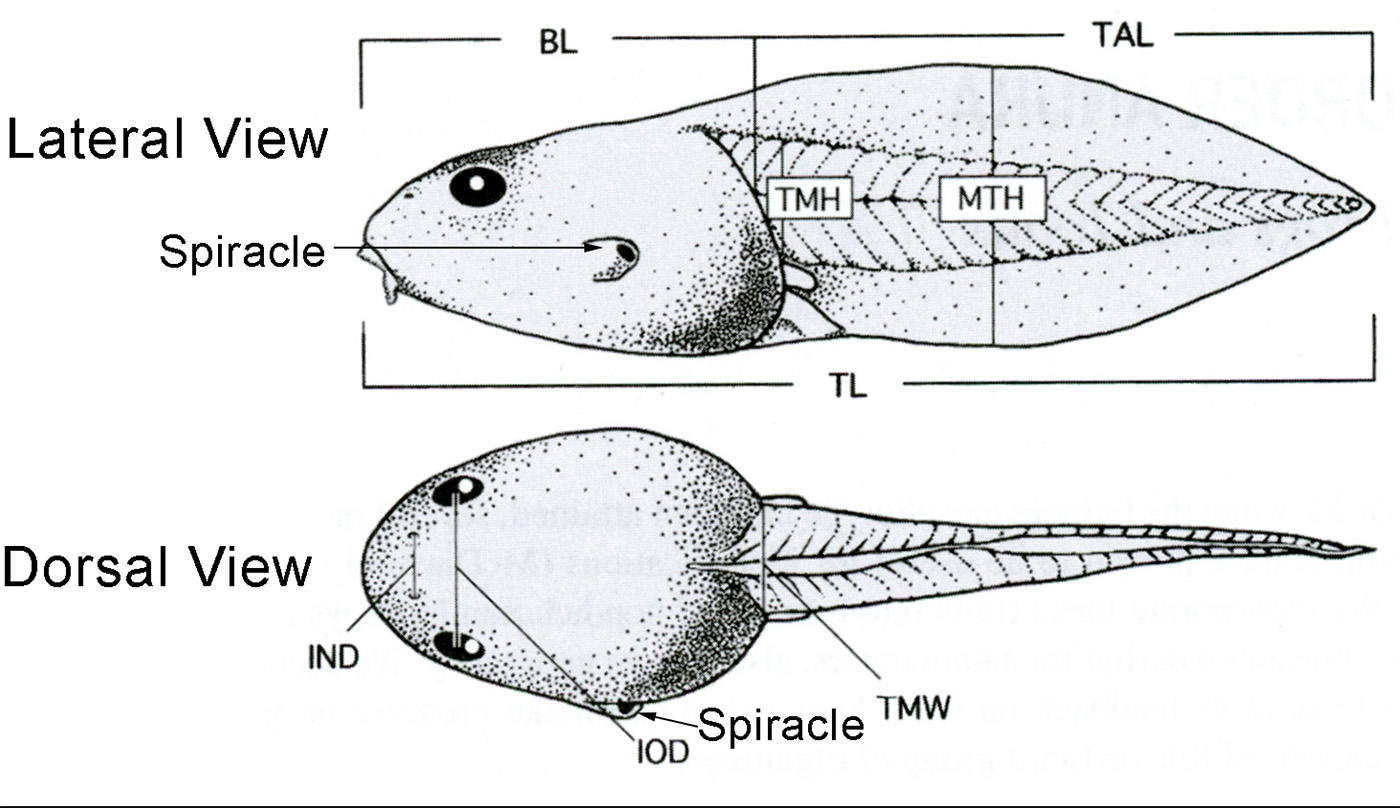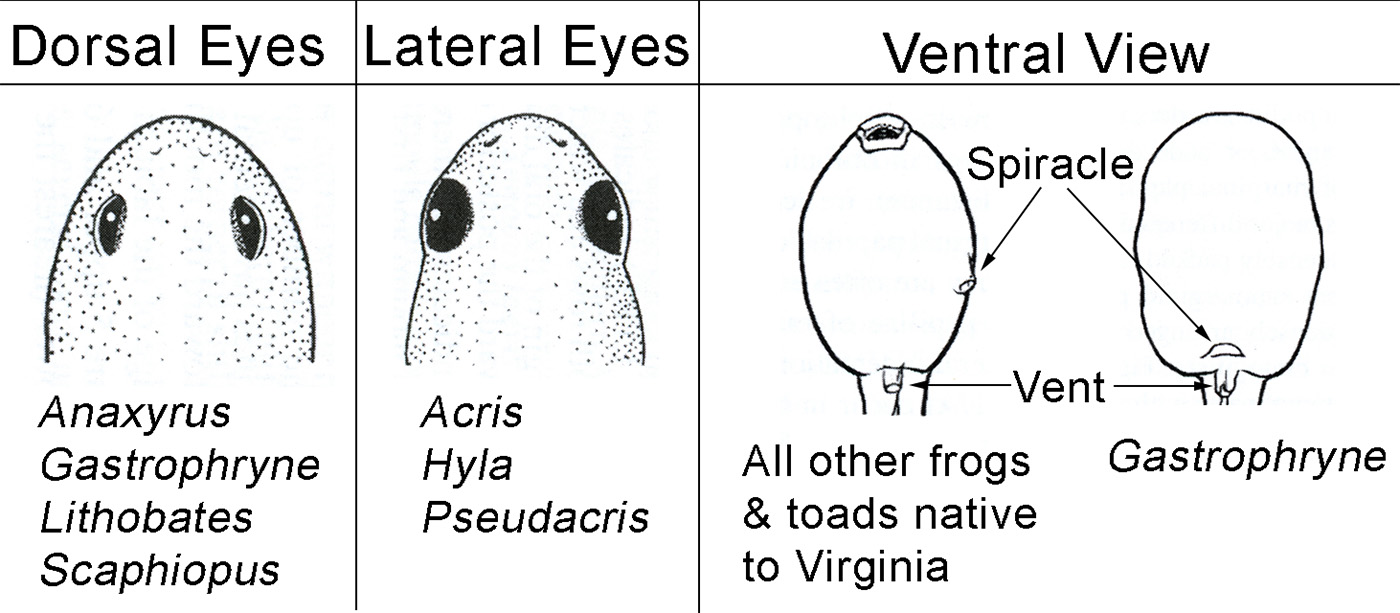Little Grass Frog
Pseudacris ocularis
Common Name: |
Little Grass Frog |
Scientific Name: |
Pseudacris ocularis |
Etymology: |
|
Genus: |
Pseudacris is derived from the Greek words pseudes meaning "false" and akris meaning "locust" |
Species: |
ocularis is Latin meaning "of the eye". Referring to the ocular stripe. |
Average Length: |
0.4 - 0.6 in. (1.1 - 1.6 cm) |
Virginia Record Length: |
|
Record length: |
0.7 in. (1.7 cm) |
Virginia Wildlife Action Plan Rating Tier IV (Moderate Conservation Need) - The species may be rare in parts of its range, particularly on the periphery. Populations of these species have demonstrated a significant declining trend or one is suspected which, if continued, is likely to qualify this species for a higher tier in the foreseeable future. Long-term planning is necessary to stabilize or increase populations.
Physical Description - This is the smallest frog in North America ranging in size from 11-19 mm (7/16 to 3/4 in). Its dorsal coloration ranges from gray to brown to reddish. A characteristic dark stripe extends from nostril through the eye onto the sides. A dark middorsal stripe is sometimes present. The ventral coloration is yellowish or white. The toes are slightly webbed. This species is sometimes confused with immature Brimley's chorus frogs.
Historical versus Current Distribution - Little Grass Frogs (Pseudacris ocularis) are found in the southeastern Coastal Plain (Harper, 1939) from southeastern Virginia to the southern tip of Florida, inland to the Fall Line and west to Choctawhatchee Bay in the Florida Panhandle (Moler, 1982; Conant and Collins, 1991; Jensen, 1994). Harper (1935) reported Little Grass Frogs from Key West, Florida, however this record was challenged by Duellman and Schwartz (1958). A record of Little Grass Frogs from Texas (Burt, 1936) was later determined to be a misidentified western chorus frog (Pseudacris triseriata; Franz and Chantell, 1978). Brandt (1936a) reported little grass frogs from Mississippi that were almost certainly misidentifications. A report of little grass frogs from the upper Gulf Coastal Plain of Georgia, specifically Fort Benning Military Reservation (Goodman, 1958), is quite distant from the nearest confirmed record. Many colleagues and I have spent considerable time in this area without encountering Little Grass Frogs, therefore this record should be considered suspect as well. Misidentifications are not surprising, especially when one considers that several authorities have addressed possibilities that the original description of Little Grass Frogs was based on a specimen of Acris (Harper, 1939; Mittleman, 1946). Indeed, some field guides state possible confusion between juvenile Acris, other Pseudacris spp., and adult Little Grass Frogs (including Martof et al., 1980; Ashton and Ashton, 1988). Unless suspected misidentifications were in fact Little Grass Frogs, there is no information available to indicate a change in this species’ distribution.
Historical versus Current Abundance - These are common frogs throughout much of their range, and no significant change in their abundance has been noted.
Breeding - Reproduction is aquatic.
Breeding migrations - Throughout most of their range, Little Grass Frogs breed from January–September (Harper, 1939) with a peak in Florida during March–April (Ashton and Ashton, 1988). Little Grass Frogs breed throughout the year in Florida (Carr, 1940a; Einem and Ober, 1956).
Breeding habitat - Little Grass Frogs breed in shallow, grassy, rain-filled depressional wetlands, including roadside ditches and semi-permanent ponds (Harper, 1939; Mount, 1975; Gibbons and Semlitsch, 1991).
Egg deposition sites - Eggs are deposited on the pond bottom or on submerged vegetation (Wright, 1923).
Clutch size - Wright and Wright (1949) reported that Little Grass Frogs deposit about 100 eggs, although Bartlett and Bartlett (1999a) suggested that > 200 eggs may be laid by a single female. Eggs are laid singly (Wright, 1923) or in several clusters of 25 or more (Bartlett and Bartlett, 1999a). Hatching occurs in 1–2 d (Ashton and Ashton, 1988).
Altig & McDiarmid 2015 - Classification and Description:
- Eastern Mass
- Arrangement 3 - Capsular chambers absent, so ova centered in inner jelly layers mass usually 45 mm diameter or less (note: particularly difficult group with minimal data).
- Sub-arrangement C - Ovum Diameter 0.6-0.8 mm; Egg Diameter 1.2-2.0 mm.
- Arrangement 3 - Capsular chambers absent, so ova centered in inner jelly layers mass usually 45 mm diameter or less (note: particularly difficult group with minimal data).
Length of larval stage - From 45–70 d (Wright and Wright, 1949).
Tadpoles:

| Lateral View | Dorsal View |
|---|---|
| BL = Body Length | IND = Internarial Distance |
| MTH = Maximum Tail Height | IOD = Interorbital Distance |
| TAL = Tail Length | TMW = Tail Muscle Width |
| TL = Total Length | |
| TMH = Tail Muscle Height |

Larvae Food - Unknown, but tadpoles likely graze on algae.
Cover - Tadpoles are most readily captured in relatively dense emergent and submerged vegetation.
Larval polymorphisms - Unknown and unlikely for this species.
Features of metamorphosis - Newly transformed froglets are 7–9 mm SVL (Wright, 1932; Gosner and Rossman, 1960).
Post-metamorphic migrations - Unknown.
Juvenile Habitat - Unknown, but likely similar to adults.
Adult Habitat - Little Grass Frogs use grass, sedge, and/or sphagnum habitats in or near cypress ponds, bogs, pine flatwoods and savannas, river swamps, and ditches (Harper, 1939; Wright and Wright, 1949; Mount, 1975; Gibbons and Semlitsch, 1991). They have been found calling from vegetation within brackish ditches (Neill, 1958a), though it is unknown whether reproduction is attempted or successful in such waters. Adults are capable of climbing vines, tree trunks, and bushes to a height of 1.5 m high or more (Harper, 1939; Wright and Wright, 1949). Harper (1939) found an inactive individual beneath a log in a dried-up cypress pond. Little Grass Frogs are often active both day and night. There is no information to indicate differing habitat characteristics between the sexes.
Home Range Size - Unknown.
Territories - Unknown.
Aestivation/Avoiding Dessication - In some areas, Little Grass Frogs are active year-round (Carr, 1940a; Einem and Ober, 1956).
Seasonal Migrations - Related to breeding (see “Breeding migrations" above).
Torpor (Hibernation) - In some areas, Little Grass Frogs are active throughout the year (Carr, 1940a; Einem and Ober, 1956). In fact, Harper (1939) stated that except “possible suspension of activity during cold spells of a few days’ duration,” Little Grass Frogs doubtfully hibernate in the Okefenokee (southeastern Georgia) region.
Interspecific Associations/Exclusions - Little Grass Frogs breed along with other chorus frogs (Ashton and Ashton, 1988) including Ornate Chorus Frogs (P. ornata; Mount, 1975) and Southern Chorus Frogs (P. nigrita), as well with other frogs such as Coastal Plains Leopard Frog (Lithobates sphenocephalus utricularius), Cope's Gray Treefrogs (Dryophytes chrysoscelis), and Southern Cricket Frogs (Acris gryllus; personal observations).
Age/Size at Reproductive Maturity - Little Grass Frogs are the smallest North American frog (Conant and Collins, 1991) with males ranging in size from 11.5–15.5 mm and females 12.0–17.5 mm SVL (Wright and Wright, 1949), although the maximum reported size is 20 mm (Franz and Chantell, 1978).
Longevity - Unknown.
Feeding Behavior - Marshall and Camp (1995) found that Little Grass Frogs eat a wide variety of arthropods, especially insects. Springtails, hymenopterans (mainly ants and parasitic wasps), rove beetles, and homopterans, in that order, were the most abundant prey items consumed. Arachnids (primarily mites) were the only non-insect prey eaten. Most of the prey items are associated with leaf litter and/or soil, suggesting that Little Grass Frogs frequently forage on the ground.
Predators - Owen and Johnson (1997) reported predation on a Little Grass Frog by a wolf spider (Lycosa sp.) and suggested that Little Grass Frogs may be important prey items for many species of vertebrates and invertebrates.
Anti-Predator Mechanisms - Despite their tiny size, Little Grass Frogs can leap 15–22 cm (1–1.5 ft; Wright and Wright, 1949) to avoid predation. Little Grass Frogs are often cryptically colored similar to the dead grass and sedge blades in which they inhabit. The stripes through their eyes and along the sides may help to break-up their outline to visually oriented predators.
Diseases - Unknown.
Parasites - The nematode Spironoura catesbianae has been found in Little Grass Frogs (Yamaguti, 1961).
Conservation - Little Grass Frogs are not protected by either state or federal laws. They remain common throughout much of their range, and no substantial changes in their abundance have been noted.
References for Life History
- Altig, Ronald & McDiarmid, Roy W. 2015. Handbook of Larval Amphibians of the United States and Canada. Cornell University Press, Ithaca, NY. 341 pages.
- AmphibiaWeb. 2020. University of California, Berkeley, CA, USA.
- Conant, Roger and, Collins, John T., 2016, Peterson Field Guide: Reptiles and Amphibians, Eastern and Central North America, 494 pgs., Houghton Mifflin Company., New York
- Duellman, William E. and, Trueb, Linda, 1986, Biology of Amphibians, 671 pgs., The Johns Hopkins University Press, Baltimore
- Martof, B.S., Palmer, W.M., Bailey, J.R., Harrison, III J.R., 1980, Amphibians and Reptiles of the Carolinas and Virginia, 264 pgs., UNC Press, Chapel Hill, NC
- Wilson, L.A., 1995, Land manager's guide to the amphibians and reptiles of the South, 360 pp. pgs., The Nature Conservancy, Southeastern Region, Chapel Hill, NC
Photos:
*Click on a thumbnail for a larger version.
Verified County/City Occurrence
Isle of Wight
Prince George
Southampton
Surry
Sussex
CITIES
Chesapeake
Suffolk
Verified in 5 counties and 2 cities.
U.S. Range

















